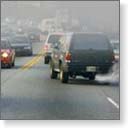| Ozone |

Ozone is a strong irritant of the mucous membranes, especially the respiratory tract. It causes constriction of the airways, which makes breathing difficult and produces coughing, wheezing, and shortness of breath. Ozone can also be involved in the development of asthma. Lastly, it increases the vulnerability of the lungs to infection. Those particularly susceptible to adverse effects from exposure to ozone include young children, the elderly, and people with asthma, chronic bronchitis, or emphysema. However, adverse effects are not confined to this sensitive population. Even healthy adults may experience such symptoms if a lot of time is spent outdoors or vigorous exercise is carried out during periods of high ozone levels. The irritation caused by ozone may be further aggravated by other air pollutants like the sulfur dioxide produced by fossil fuel combustion from motor vehicles, homes, power plants, and industry.
"There's this bike path near my house, but when I walk or run on it on ozone alert days I spend the next few hours coughing." -- Melissa, age 68 |
Ozone forms from the interaction of nitrogen oxides emitted from motor vehicles, power plants, and industrial facilities and volatile organic compounds from spray painting, refueling of vehicles, road paving, and numerous other activities. Sunlight provides the catalyst for this reaction. Large urban areas have higher levels of ozone due to greater amounts of smog associated with the aggregation of people and air pollution-producing activities. The hot temperatures and stale air in the summer in combination with urban air pollution furnish ideal conditions for the formation of ozone. Due to its hot arid climate, its geological features, and the large number of people, the Los Angeles metro area is consistently plagued with higher ozone levels than the rest of the nation. However, several other large metropolitan areas in the U.S. also have severe ozone problems as indicated in the U.S. EPA's National Air Quality Status and Trends through 2007 report.
Since ozone is a major air pollutant having negative impact on human health, in 2008 the U.S. EPA tightened its National Ambient Air Quality Standard (NAAQS) to 0.075 parts per million in the ambient air for an 8-hour time period. It is estimated that more than 51 million Americans live in locations where ozone levels exceed the EPA's present standard. The EPA lowered the 1997 standard based on the results of recent research indicating negative health impacts of ozone.
Created by the National Institute of Environmental Health Sciences. Image and quote copyright A.D.A.M., Inc.
|
Review Date:
6/29/2011 Reviewed By: Paula J. Busse, MD, Assistant Professor of Medicine, Division of Clinical Immunology, Mount Sinai School of Medicine, New York, NY, Review provided by VeriMed Healthcare Network. Also reviewed by David Zieve, MD, MHA, Medical Director, A.D.A.M., Inc. |
